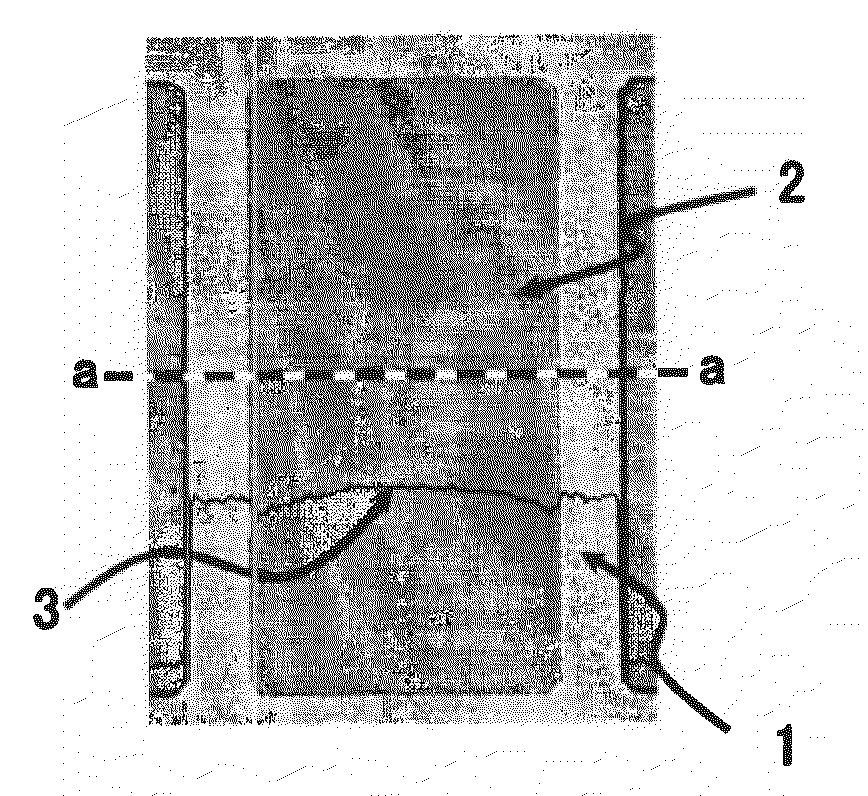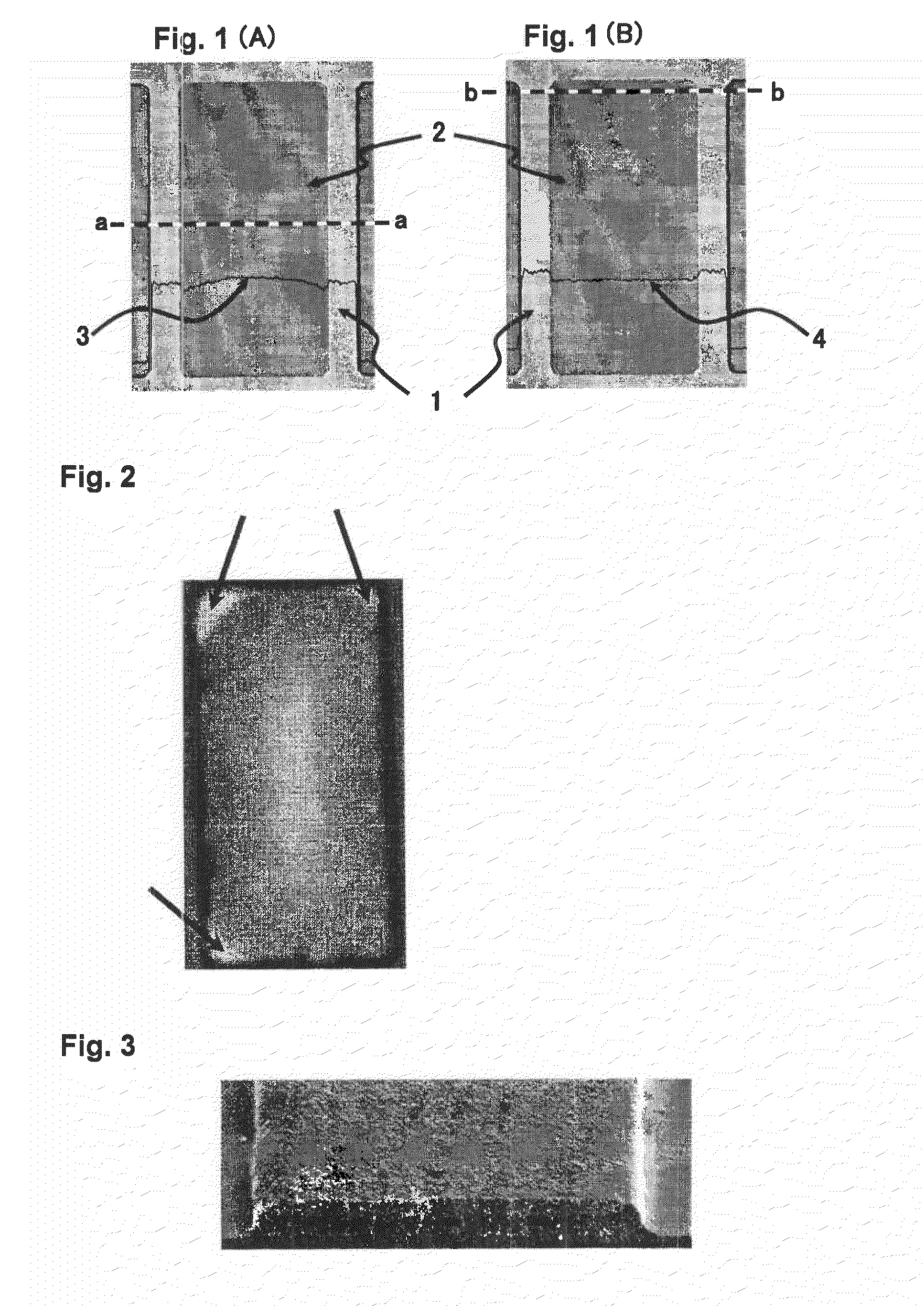Process for producing substrate having partition walls and pixels formed thereon
a technology of partition walls and substrates, applied in the direction of photomechanical equipment, instruments, originals for photomechanical treatment, etc., can solve the problems of non-uniform achieve excellent in liquid repellency, suppress color mixing of inks, and excellent in the thickness of ink layers
- Summary
- Abstract
- Description
- Claims
- Application Information
AI Technical Summary
Benefits of technology
Problems solved by technology
Method used
Image
Examples
preparation example 1
Polymerization Reaction
[0213]Into an Autoclave Having an Internal Capacity of 1 L and Equipped with a stirrer, acetone (556.0 g), C6FMA (96.0 g), MAA (4.8 g), 2-HEMA (96.0 g), MMA (43.2 g), a chain transfer agent 2-ME (6.2 g) and a polymerization initiator V-70 (4.5 g) were charged and polymerized at 40° C. for 18 hours with stirring in a nitrogen atmosphere to obtain a solution of copolymer 1. The weight average molecular weight of copolymer 1 was 5,600.
[0214]To the obtained acetone solution of copolymer 1, water was added for reprecipitation for purification, and then reprecipitation for purification was carried out by means of petroleum ether, followed by vacuum drying to obtain 237 g of copolymer 1.
(Introduction of Ethylenic Double Bonds)
[0215]Into a glass flask having an internal capacity of 500 mL and equipped with a thermometer, a stirrer and a heating device, copolymer 1 (100 g), MOI (47.7 g), DBTDL (0.19 g), BHT (2.4 g) and acetone (100 g) were charged and polymerized at 30...
preparation examples 2 to 6
[0216]Copolymers 2 to 6 were obtained by a polymerization reaction in the same manner as in the preparation of copolymer 1 except that the mixing (unit: g) of materials was changed as identified in Table 1. Then, polymers (A2) to (A5) each having a side chain containing an ethylenic double bond and polymer (R1) having no side chain containing an ethylenic double bond were obtained by the same reactions as in the preparation of polymer (A1) except that mixing (unit: g) of materials was changed as identified in Table 2.
[0217]The weight average molecular weight of the obtained polymer, the content of fluorine atoms in the polymer, the number of ethylenic double bonds (C═C) in one molecule and the acid value (mgKOH / g) are shown in Table 2.
TABLE 1PolymerizationPreparation Examplesreaction123456C6FMA9612096969696DMS————4.8—MAA4.89.62428.8249.62-HEMA9696969696—MMA43.2————86.4IBMA—38.42419.219.248V704.53.54.23.64.24.42ME6.26.56.27.86.26.2Acetone556557556556556556Copolymer123456Yield23723823...
preparation example 7
[0218]Into an autoclave having an internal capacity of 1 L and equipped with a stirrer, acetone (555.0 g), AA (96.0 g), 2-HEMA (96.0 g), IBMA (48.0 g), a chain transfer agent DSH (9.7 g) and a polymerization initiator V-70 (7.1 g) were charged and polymerized at 40° C. for 18 hours with stirring in a nitrogen atmosphere to obtain a solution of polymer 7. The weight average molecular weight of polymer 7 was 9800.
[0219]To the obtained acetone solution of polymer 7, water was added for reprecipitation for purification, and then reprecipitation for purification was carried out by means of petroleum ether, followed by vacuum drying to obtain 240 g of polymer 7.
[0220]Then, into a glass flask having an internal capacity of 300 mL equipped with a thermometer, a stirrer and a heating device, polymer 7 (100 g), MOI (48.3 g), DBTDL (0.19 g), BHT (2.4 g) and acetone (100 g) were charged and polymerized at 30° C. for 18 hours with stirring to obtain a solution of alkali soluble photosensitive re...
PUM
| Property | Measurement | Unit |
|---|---|---|
| photosensitive | aaaaa | aaaaa |
| thickness | aaaaa | aaaaa |
| pressure | aaaaa | aaaaa |
Abstract
Description
Claims
Application Information
 Login to View More
Login to View More - R&D
- Intellectual Property
- Life Sciences
- Materials
- Tech Scout
- Unparalleled Data Quality
- Higher Quality Content
- 60% Fewer Hallucinations
Browse by: Latest US Patents, China's latest patents, Technical Efficacy Thesaurus, Application Domain, Technology Topic, Popular Technical Reports.
© 2025 PatSnap. All rights reserved.Legal|Privacy policy|Modern Slavery Act Transparency Statement|Sitemap|About US| Contact US: help@patsnap.com



